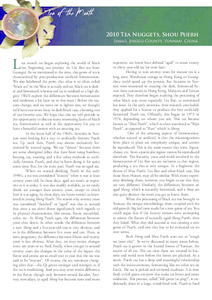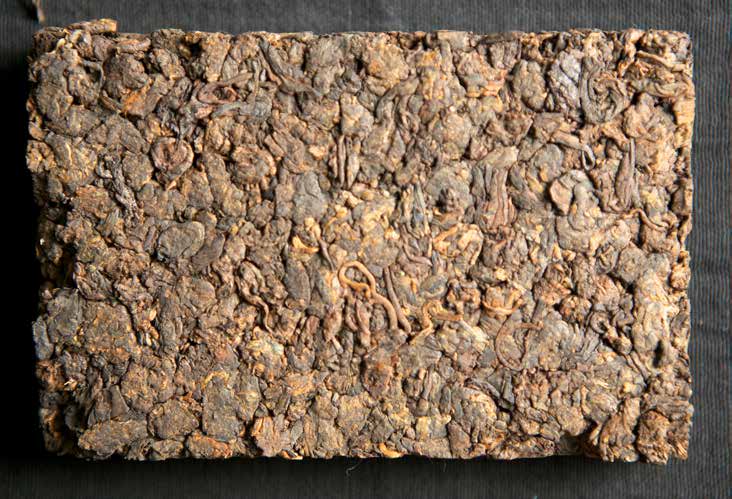
 |
|
Last month we began exploring the world of black tea, beginning our journey via Liu Bao tea from Guangxi. As we mentioned at the time, this genre of tea is characterized by post-production artificial fermentation. We also belabored the point that what is so often called "black tea" in the West is actually red tea. black tea is darker and fermented, whereas red tea is oxidized to a high degree. (We'll explore the differences between fermentation and oxidation a bit later on in this issue.) Before the seasons change, and we move on to lighter teas, we thought we'd have one more foray in dark/black teas, choosing one of our favorite teas. We hope that this tea will provide us the opportunity to discuss many interesting facets of black tea, fermentation as well as the opportunity for you to have a beautiful session with an amazing tea.
In the latter half of the 1960's, factories in Yunnan were looking for a way to artificially ferment Puerh tea. Up until then, Puerh was almost exclusively fermented by natural aging. We say "almost" because there are some aboriginal tribes that have been using bamboo, burying tea, roasting and a few other methods to artificially ferment Puerh, and they've been doing it for quite some time. But, for the most part, Puerh was an aged tea.
When we started drinking Puerh in the early 1990's, a tea was considered "mature" when it was at least seventy years old. In those days, aged tea wasn't as expensive as it is today. It was also readily available, so we rarely drank tea younger than seventy years, except to check how it was aging. In those days, tea lovers weren't so interested in young Sheng Puerh. The reason why seventy years was considered "finished" or "aged" was that at around that time a tea slows down significantly with regards to its physical characteristics, like aroma, flavor, mouthfeel, color, etc. As Sheng Puerh ages, the differences between years slow down. In other words, the difference between a new Sheng and a five-year-old one is very obvious, and so is the difference between five years and ten. Then, as time progresses, the difference between fifteen and twenty years is less obvious. After that, we may notice changes every ten years or so. And, finally, when you get to around seventy years the changes in the color of the liquor, the flavor and aroma are so small year to year that the tea was said to be "mature". Of course, the tea continues changing after that - the Qi grows stronger and stronger, as if the tea is meditating. And you may even notice difference in the flavor, though only between several decades. Anyway, nowadays, as aged Sheng has become rarer and more expensive, tea lovers have defined "aged" to mean twenty or thirty-year-old tea (or even less).
Having to wait seventy years for mature tea is a long time. Warehouse storage in Hong Kong or Guangzhou could speed up the process, but factories in Yunnan were interested in creating the dark, fermented flavors their customers in Hong Kong, Malaysia and Taiwan enjoyed. They therefore began studying the processing of other black teas, most especially Liu Bao, as mentioned last issue. In the early seventies, their research concluded, they applied for a license to produce the first artificially fermented Puerh tea. Officially, this began in 1973 or 1974, depending on whom you ask. This tea became known as "Shou Puerh", which is often translated as "Ripe Puerh", as opposed to "Raw" which is Sheng.
One of the amazing aspects of fermentation, whether natural or artificial, is that the microorganisms from place to place are completely unique, and cannot be reproduced. This is the main reason that wine, liquor, cheese, etc. from a particular region cannot be reproduced elsewhere. The bacteria, yeast and mold involved in the fermentation of Liu Bao tea are exclusive to that region, producing a tea that is very unique. To a beginner, the flavors of Shou Puerh, Liu Bao and other black teas, like those from Hunan, may all be similar. With more experience drinking them, however, you begin to see that they are very different. Similarly, the differences between an aged Sheng, which is naturally fermented, and a Shou are also quite distinct the more you get to know them.
When the processing of black tea was brought to Yunnan, the unique microbiology there, coupled with the old-growth, big leaf trees made for a new genre of tea. You could argue that if the factory owners were attempting to mimic the flavors of naturally aged Sheng Puerh, then they failed. What they did succeed at was creating a new genre of Puerh, and one that has to be evaluated on its own terms.
Both Sheng and Shou Puerh start out as "rough tea (mao cha)". As we've discussed in many issues before, Puerh tea is grown in the humid forests of Yunnan, the source of all tea. The tea trees there are covered in bacteria and mold even before the leaves are plucked. As a result, Puerh tea has a deep and meaningful relationship with the micro-environs, fermenting like no other tea on Earth. The tea is picked and withered outdoors. It is then fired, to kill green enzymes that make tea bitter and arrest oxidation. This process, called "kill-green (sa qing)", is traditionally done in a large, wood-fired wok. Puerh is fired at a lower temperature than many of kinds of tea, which keeps certain enzymes around that are good for fermentation. The tea is then rolled (rou nian) to break down the cell walls and shape the tea. At this point, the rough tea could be sold loose-leaf, compressed and sold as Sheng Puerh, or go on to become Shou Puerh, like our Tea of the Month.

If the tea is to be Shou, it is piled about a meter high, dampened with water and often covered with thermal blankets. The heat and moisture allow the bacteria, mold and yeast to get to work. We think it is a shame that modern people have a tendency to dismiss that which science has a working explanation for. In other words, when we find out that the Northern Lights are a meteorological phenomenon caused by the Earth's magnetic field, they somehow lose their charm for certain people. However, being able to explain why a phenomenon occurs in Nature isn't any reason why it should be considered bland, or dismissed as "ordinary". The fact is that the changes that happen to Puerh through fermentation, whether naturally aged or artificially, are completely magical! It is stunning that these yeasts, molds and bacteria can interact with these leaves and create the amazing differences in our tea drinking experience - on every level, from aroma and flavor to Qi and spiritual depth!
The piling of Shou Puerh is called "wo dui" in Chinese. Typically, during the fermentation process to make ripe Puerh the pile is kept wet to facilitate microbial growth, and turned every few days to help create an even degree of fermentation. The tea is moved from the bottom of the pile where it is hotter and wetter to the top of the pile where it is cooler and drier. Depending on the degree of artificial fermentation, the tea will be piled for different lengths of time. Nowadays, this process lasts around forty-five days.
We have found that most modern Shou is fully fermented, whereas the Shou Puerhs made in the 70's, 80's and up to the mid 1990's were only partially fermented. This allowed them to age. In fact, many of these older Shou teas could be convincingly brewed as aged Sheng and the beginner wouldn't be able to tell the difference. Also, the quality of these partially-fermented Shou teas is usually higher, as stopping the piling at the right time requires more skill and more careful monitoring of the process. The careful monitoring of this month's tea as it was piled, stopping the fermentation at a certain point, is one of the characteristics that make it great.

Our Tea of the Month is a very special kind of Shou Puerh that, until very recently, wasn't often seen outside the factory. This month we'd like to share with you one of our favorite miracles of this artificial fermentation: Tea Nuggets, called "Cha Tou" in Chinese. Cha Tou are leaves that ball up and get stuck together, usually near the bottom of the pile, where the temperature is hotter and there is more moisture. Also, the weight of the tea causes it to compress (just like Liu Bao, which often compresses into four large discs, as Liu Bao is pushed into the large baskets). Traditionally, these nuggets weren't often used in the commercial lines of Shou Puerh offered by factories. Since the early 2000's, however, more of this tea has begun to reach the market; and for good reason! The best nuggets of Shou are smaller in size, and haven't over-fermented. Most of the Cha Tou in yesteryears weren't used because they weren't picked out of the piles and therefore always over-fermented. Nowadays, they are a treat, and are often picked out of the pile early to produce fine teas like the one we are all going to share together this month.
Our Tea of the Month was harvested in Spring of 2010 in Jinggu County of Simao Prefecture (recently renamed "Puerh"), Yunnan. The tea was then stored and piled/fermented that August-September at the Jinggu Tea Factory. Afterwards, the tea nuggets were allowed to mellow out until mid-May of 2011, when they were compressed into bricks at the Kunming Tea Factory, the first factory ever to produce Shou Puerh - back in the early 1970's! The bricks are highly-compressed using hydraulic machines, since the little nuggets need a lot of pressure to stick together. These little nuggets are the most active microclimates in the piles of tea that become Shou Puerh. The liquor is creamier, richer and darker than ordinary Shou. They are also more "patient (nai pao)", which means that they can be infused more times. The tea tastes like sweet dates or even chocolate, creamy and rich. Be sure to use very hot water, as the nuggets don't open so easily. You may even want to try boiling a bit of this tea, maybe to start with or even after you brew it a few times in a pot.

We find this tea to be so warming, creamy and earthy that it brings us into our hearts, dropping our energy to the ground. It makes you want to sit crosslegged on the floor, and reminds your guests where all life on this planet starts from - the soil! The Qi descends in Yang swirls, and invites you to ground yourself. It is one of our favorite Winter teas, and we always have some at the end of Winter in farewell to the dark teas and dark days. We also find it satisfying, almost like soup or a meal. The warmth of this tea is best shared, of course. Whether you share it with friends or not, remember you are sharing it with all of us together - hundreds of us now, and from around the world!
